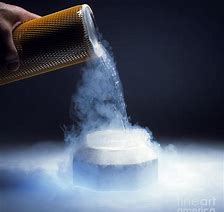

The wheat sheaf symbol and lightning reflect the importance of nitrogen to living things. Nitrogen is important for plant growth and can be ‘fixed’ by lightning or added to soils in fertilisers.
| Density | 0.001145 |
| Melting Point | −210.0°C |
| Boiling Point | −195.795°C |
Nitrogen is important to the chemical industry. It is used to make fertilisers, nitric acid, nylon, dyes and explosives. To make these products, nitrogen must first be reacted with hydrogen to produce ammonia. This is done by the Haber process. 150 million tonnes of ammonia are produced in this way every year.
Nitrogen gas is also used to provide an unreactive atmosphere. It is used in this way to preserve foods, and in the electronics industry during the production of transistors and diodes. Large quantities of nitrogen are used in annealing stainless steel and other steel mill products. Annealing is a heat treatment that makes steel easier to work.
Liquid nitrogen is often used as a refrigerant. It is used for storing sperm, eggs and other cells for medical research and reproductive technology. It is also used to rapidly freeze foods, helping them to maintain moisture, colour, flavour and texture.
Nitrogen in the form of ammonium chloride, NH4Cl, was known to the alchemists as sal ammonia. It was manufactured in Egypt by heating a mixture of dung, salt and urine. Nitrogen gas itself was obtained in the 1760s by both Henry Cavendish and Joseph Priestley and they did this by removing the oxygen from air. They noted it extinguished a lighted candle and that a mouse breathing it would soon die. Neither man deduced that it was an element. The first person to suggest this was a young student Daniel Rutherford in his doctorate thesis of September 1772 at Edinburgh, Scotland.